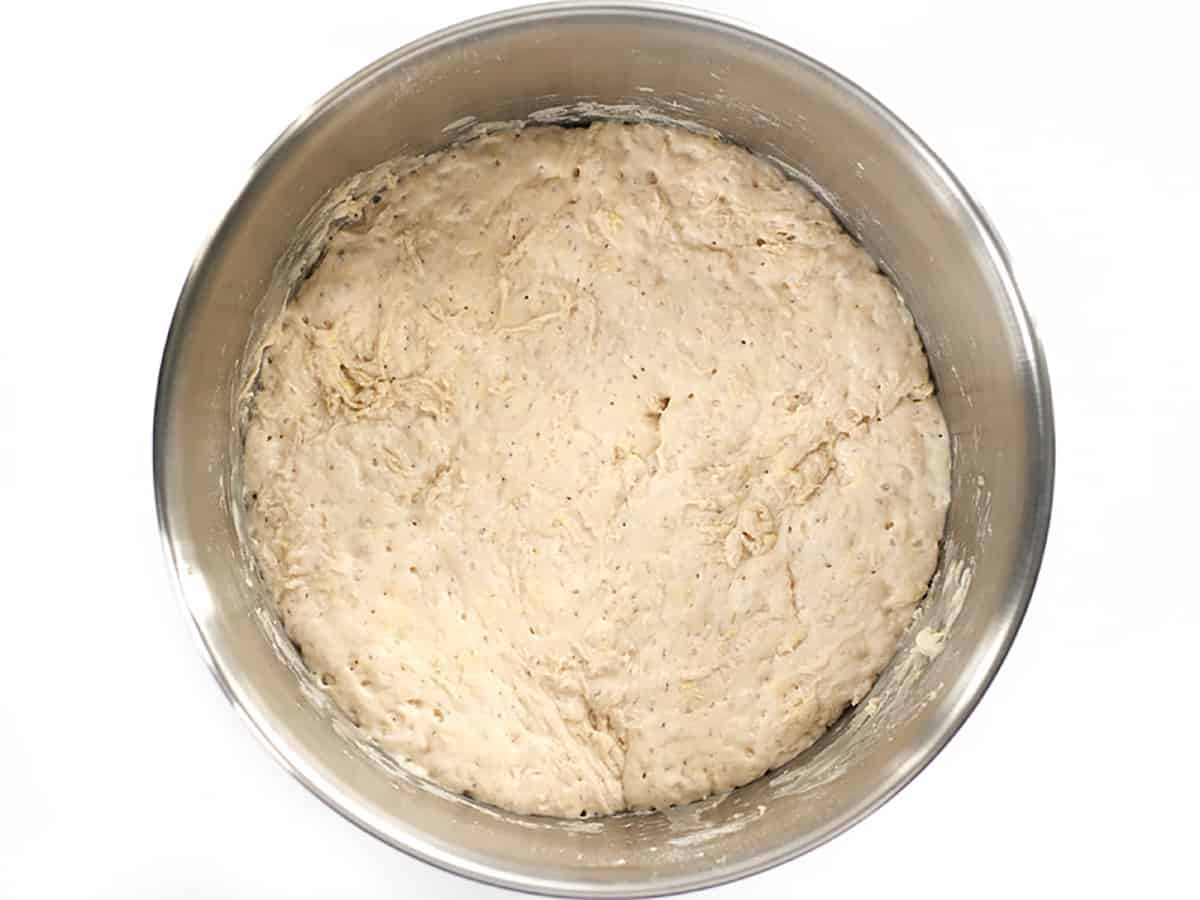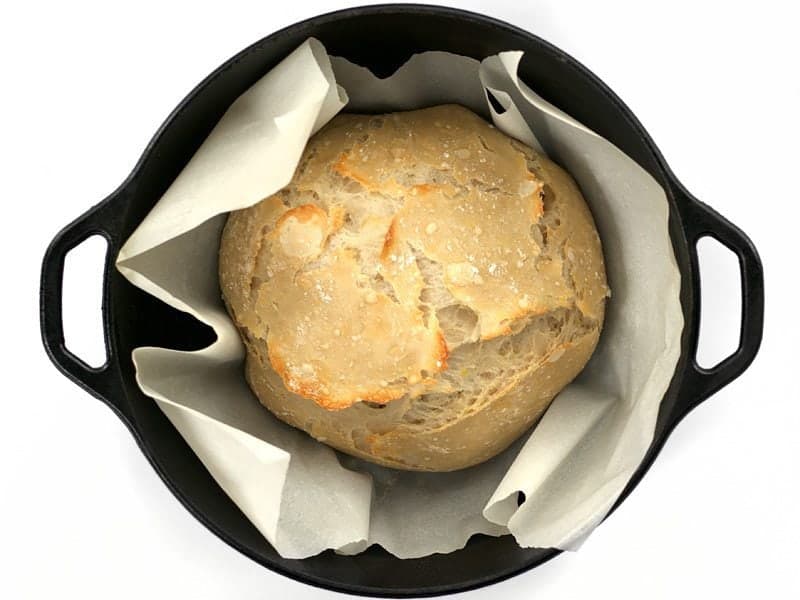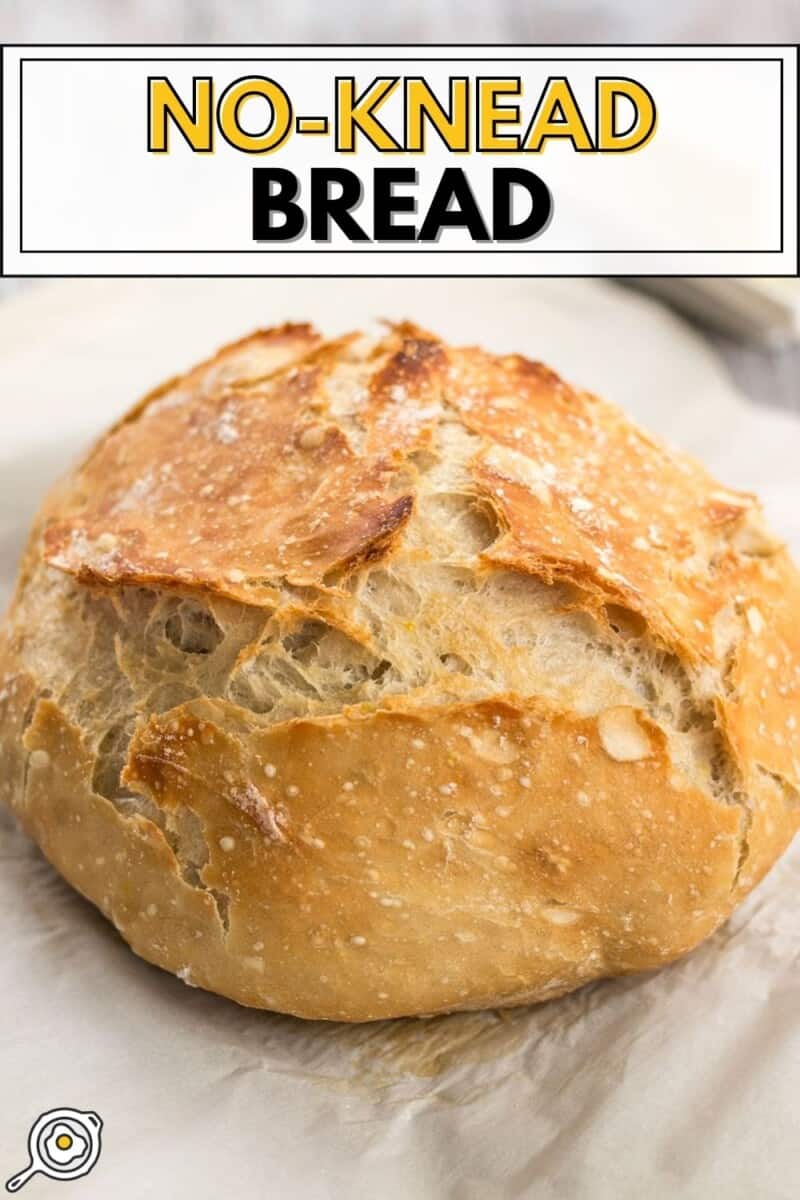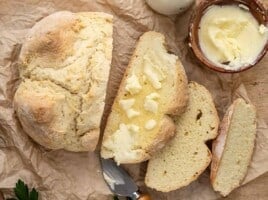I started making no-knead bread in 2010 and it has continued to be my favorite way to make homemade bread because it’s incredibly simple, it doesn’t require a lot of effort, and it makes the most deliciously crusty bakery-style bread ever. To make this no-knead bread recipe you only need four ingredients (including water) and a little bit of time. No fancy equipment or techniques needed!

This post contains some affiliate links, which means that we make a small commission off items you purchase at no additional cost to you.
“I’ve made this twice and it was amazing! Hard to believe something so simple can come together to be something so amazing!”
-Melissa
What Is No Knead Bread?
No-knead bread is an ancient technique for making delicious loaves of bread by utilizing a long fermentation time to develop the gluten the flour instead of hand kneading. Gluten is the protein that gives bread its strength, allowing it to rise into a fluffy loaf, and have that deliciously chewy texture. Kneading bread dough develops gluten quickly, but is quite labor-intensive. If given enough time, yeast can develop the gluten in the dough without the need for manual needing.
Ingredients for No Knead Bread
The best part about this no-knead bread recipe is that it only requires four ingredients, including water, and you still get an incredibly flavorful bread. Here’s all you’ll need to make your own homemade no-knead bread:
- Flour: Our version of no-knead bread was developed using all-purpose flour because that is what we most commonly have on hand. That being said, using bread flour will create even better results. Just keep in mind that bread flour tends to absorb more water than all-purpose flour, so you may need to adjust the ratios slightly.
- Yeast: For this type of bread, we use instant yeast or bread machine yeast, both of which do not need to be activated first by proofing in warm water. You can simply add them to your dry ingredients and go!
- Salt: Without the proper amount of salt, homemade bread will have no flavor, so it’s imperative that you do not skip the salt.
- Water: Water hydrates the flour to create the dough. Because this technique uses a longer ferment time, you can use room-temperature water and you do not have to “wake up” the yeast with warm water. The yeast will have plenty of time to activate as it rests.
What Kind of Yeast to Use
It’s very important to use the correct type of yeast for this recipe. Instant yeast and bread machine yeast are special because they do not require mixing with warm water to “wake up” before adding to a recipe. You can simply stir them into the dry ingredients and they will activate instantly upon hydration, so that is what we use for this super simple no-knead bread technique. Active Dry yeast, on the other hand, needs to be specifically activated in warm water first. If you use active dry yeast in this recipe using the technique below, the bread will likely not rise.
Do I Need to Use a Dutch Oven?
Using a preheated Dutch oven does create the best results because it gives the bread an extra intense boost of heat while retaining all of the moisture and steam. That being said, I have made no-knead bread on a sheet pan with great results! I suggest adding a pan with an inch or so of water on the bottom rack of your oven to create steam if you’re baking your bread on a sheet pan.
If possible, I would suggest investing in a Dutch Oven because they are easily one of the most flexible and useful pieces of cookware. We love our Amazon Basics 6-Quart Enameled Dutch Oven as a very affordable alternative to Le Creuset. Lodge also makes very affordable Enameled Dutch Ovens and plain Cast Iron Dutch Ovens (like the one used in the photos here).
Short Fermentation vs. Long Fermentation
You can make no-knead bread using either a long fermentation (12-18 hours) or a short fermentation (about 2 hours). The difference is that you’ll need more yeast to do the short fermentation and the flavor does not develop quite as deeply. That being said, short fermentation no-knead bread is a great option when you haven’t planned ahead!
Long Fermenation: Follow the instructions below, using ¼ tsp yeast and fermenting the dough for 12-18 hours.
Short Fermentation: Use 2 tsp yeast (or one ¼ oz. packet) and ferment the dough for about 2 hours at room temperature.

No-Knead Bread

Ingredients
- 3 cups all-purpose flour ($0.29)
- 1/4 tsp instant yeast or bread machine yeast* ($0.02)
- 1.5 tsp salt ($0.02)
- 1.5 to 1.75 cup water** ($0.00)
Instructions
- The day before baking, combine the flour, yeast, and salt in a large bowl and stir until they're well combined. Stir in about 1.5 to 1.75 cups room temperature water until a shaggy, sticky ball of dough forms and there is no dry flour left on the bottom of the bowl. The dough should be wet and sticky, but not so wet that it appears glossy. Cover the bowl loosely with plastic and let it sit at room temperature for 12-18 hours.
- The next day, the dough should be fluffy and very bubbly. When you're ready to bake, sprinkle a little flour on top of the fermented dough and scrape it out of the bowl. With well-floured hands, shape the dough into a ball and place it on a piece of parchment paper. Let the dough rise for 30-60 minutes.
- While the dough is rising, preheat the oven to 425ºF, or the highest recommended temperature listed on the packaging for your parchment paper. Place the Dutch oven inside the oven as it preheats, and make sure it sits in the fully heated oven for at least 15 minutes before baking the bread.
- Once the bread has risen and the Dutch oven is fully heated, carefully remove the Dutch oven from the oven (it will be EXTREMELY hot). Lift the parchment with the dough straight into the dutch oven and cover it with the lid.
- Return the Dutch oven to the oven and bake for 30 minutes. Carefully remove the lid and bake for another 15-20 minutes, or until the crust is a deep golden brown. Remove the Dutch oven from the oven, lift the bread out by by using the parchment paper, and allow it to cool before cutting open and serving.
Sheet Pan Instructions
- Ferment and shape the dough as described above, then place it on a parchment-lined sheet pan to rise for an additional 30 minutes.
- Place a baking pan with about an inch of water on the bottom rack of the oven, then preheat to 425ºF while the dough rises.
- Once the loaf has risen for 30 minutes and the oven is fully preheated, carefully score the top of the dough with a sharp knife (use horizontal motions with no downward pressure). Transfer the sheet pan to the oven and bake for 40 minutes, or until the crust is deeply golden brown and the loaf sounds hollow when tapped.
See how we calculate recipe costs here.
Equipment
- Cast Iron Dutch Oven
- Mixing Bowls
- Parchment Paper
- Liquid Measuring Cup
Notes
Nutrition

How to Make No-Knead Bread – Step by Step Photos

Before you begin, make sure you have “instant yeast” or “bread machine yeast” rather than “active dry”. The reason you need this type of yeast specifically is because it does not need to be kick-started by mixing with warm water first. You can add it to a recipe dry and it will still activate. I buy these little jars, which I keep in my fridge, and they last for-ev-er (especially when you’re only using 1/4 tsp at a time)!

The day before you want to actually bake the bread, combine 3 cups all-purpose flour, 1/4 tsp instant or bread machine yeast, and 1/2 Tbsp salt in a large bowl. Stir them together really well.

Stir in about 1.5 to 1.75 cups of room temperature water, or just enough to form a shaggy ball of slightly sticky dough, and no dry flour is left on the bottom of the bowl. The total amount of water needed may vary from time to time depending on the ambient humidity and moisture content of the flour, so go on visuals here. Make sure it comes together in one ball and no dry flour is left on the bottom of the bowl. It’s okay for it to be a bit sticky.

Loosely cover the bowl with plastic and let the dough ferment at room temperature for 12-18 hours. If you need to let it sit longer than that to fit your schedule, just transfer it to the refrigerator. As the dough ferments, it becomes very big, light, fluffy, and bubbly.

Sprinkle a little flour onto the dough (because it will be sticky) and scrape it out of the bowl. It will begin to deflate as you scrape it out.

Using floured hands, shape the dough into a ball, then place it on a large piece of parchment. Let the dough rise for 30-60 minutes. The shorter rise time will produce a slightly more dense bread and the longer rise time will have larger bubbles.

While the dough is rising, begin to preheat the oven and the Dutch oven. Set the oven to 425ºF, or whatever the highest safest temperature is for your brand of parchment (it will usually be listed on the box somewhere). Make sure your Dutch oven is inside the oven as it preheats, and then let it heat for an additional 15 minutes or so once the oven is up to temperature. This makes sure that the Dutch oven is nice and hot.

When the dough is risen and the Dutch oven is fully preheated, carefully remove the Dutch oven from the oven (it will be extremely hot!). Lift the risen dough by the parchment and place it inside the Dutch oven, parchment and all. Place the lid on the Dutch oven and return it to the hot oven.

Let it bake for 30 minutes with the lid on the Dutch Oven, then carefully remove the lid…

Then bake it for an additional 15 minutes or so WITHOUT the lid to allow the crust to brown.

Once the crust achieves a nice deep golden brown color, carefully remove the Dutch Oven from the oven. Lift the no-knead bread out of the Dutch oven by the parchment, and allow it to cool before serving.

And just be prepared for the BEST bread you’ve ever made yourself. ;) The crust on this no-knead bread is seriously amazing.
No Dutch Oven and Short Fermentation Instructions
So, as I mentioned before, you can still bake this bread without a Dutch oven and with a short, 2-hour fermentation time. Here is a photo of my no-knead bread using just 2 hours of fermentation (plus another 1 hr rise time) and baked on a baking sheet.

If you only have about 2-3 hours to ferment the dough, you’ll need to increase the amount of yeast used to 2 tsp (instead of 1/4 tsp).
Let the dough ferment in the bowl for 2 hours, then shape it into a loaf, transfer it to a baking sheet covered with parchment (and sprinkled with cornmeal, if desired) and let rise for about another hour. I like to make slits in the top with a sharp knife after the loaf has risen. Be careful though, if the knife is not sharp enough or you use too much downward pressure, it can deflate the dough.
Brush the surface of the dough with water, then bake it in a preheated oven (again, as hot as the parchment will allow, usually around 425ºF) for 30-40 minutes, or until the crust is nicely browned.







Darcy – I’ve used the no-knead technique for loaf breads and it seems to work out well. If your dough was a little on the wet side, try working in just a little bit of flour when you’re kneading it. That might give it more strength.
I made this bread, and it was absolutely delicious! I must have gone wrong somewhere along the way though, because it did not rise nearly as much as I was hoping, and the bread is fairly flat. How do you think this recipe would hold up in a pan with more structure, like a loaf tin?
No, self rising flour will not work in this recipe. Self rising flour does not work the same way as yeast and is more for items like biscuits.
Can I use self-rising flour?
I use the New York Times recipe for No Knead Bread (18 hours with no refrigeration) and have adapted it by doubling the recipe and using mixtures of flour (white and rye, white and wheat) and adding “crunchies” like seeds for extra texture. I do not use a baking stone, instead, I use two large Corningware round casserole dishes that I’ve sprayed with Pam baking spray (with flour). Cover with the Corningware tops to bake and remove covers about 15 minutes before the end. Two perfect round loaves every time.
I made this before going to bed last night (about 10:30) and left it on the counter until this morning. I formed it into a freeform loaf and put it on a pizza pan I have (not stone but metal with holes in it) let it rest for about 30 minutes, baked for 30 minutes at 400. It turned out great!! The sourdough taste was great! My husband wants me to make more!! Thank you for sharing!!
Made this last night and I have to say it is the best bread I’ve ever made in my life! LOVE IT! I can’t believe how easy it is to make, how simple the ingredients are, and how incredibly tasty it is. I may have bread with dinner most nights of the week now. Thank you for sharing!
Hi Beth, I am so excited about this recipe. I made it for the first time yesterday and it did take ages to rise, but I guess it was quite cool in my kitchen. When I was a young child, mom used to make ‘stottie cakes’, a flatcake which was soft and chewy in the middle with a crispy crust. Sometimes she made 5-6inch diameter ones or other times she would make one large one. She never had a recipe, her mom taught her how to do it. Dad got a job at a bakery so she stopped making it, and I never did learn how. None of the bakeries sold anything that tasted the same. When I came to Canada from UK I started making my own bread on occasions. I have tried to duplicate her recipe but have never been able to, until yesterday. I made one long loaf but today I have made stottie cakes as well as buns and they are great. Thanks for sharing.
Anon – the yeast can also feed on the carbohydrates in the flour, although it takes longer than if you were to add sugar. That is why it requires a two hour rise time. Also, the dough is quite wet so it rises a lot due to steam in the super hot oven. No knead bread is not as light and fluffy as traditional breads, but it’s super tasty for the amount of work that you put in! The more you make it, the better you’ll get at it (just look at the bottom photo compared to the original one!)
I’m concerned that there is no sugar in this recipe. I thought the yeast needed sugar to make it grow. I made the dough as the recipe says almost 2 hours ago, and nothing is happening. I’ll leave it longer and see if it progresses. Love your web-site, Pat.
Krinajean – Since writing this post I’ve discovered that you really do want to have “instant” yeast rather than “active dry”. Instant doesn’t need to be dissolved in water where as active dry does. So, since you have active dry, you can just dissolve it in the water that gets added. If I remember correctly, some other people had this problem and that fixed it! I hope it works for you!
I saw this the other day and had to try it asap! Bought new “active dried yeast” for the recipe. My problem was it didn’t seem to rise that much? Am I doing something wrong… It was quite warm and humid which I thought would have helped the bread rise? Do I need to dissolve this type of yeast in the water before I add it?
It still came out successfully, yummy and ciabatta-esque! Definitely going to have another go!
Claire – Actually, I only use dry yeast! I usually buy a small jar of the instant yeast because that’s where I get the most bang for my buck. I keep it in the refrigerator and it stays good for months. I’m not really familiar with fresh yeast so I don’t know what to suggest… but if you use dry yeast, make sure to use “instant” or “bread machine” yeast because neither of those need to be dissolved in water before adding to a recipe.
Just wanted to stop by and say that this recipe has motivated me to start making my own bread! Well try to, my first batch of dough didn’t come out brilliantly – didn’t rise very well. I wonder if that is because I used quick-action dried yeast rather than fresh yeast? Is it possible to use dried yeast with this recipe?
ok, mine didn’t rise very much and was super gummy (not that it stopped us from eating it, ha!) The crust was spectacular, tho! Adding fresh yeast to my shopping list, as that’s probably the culprit.